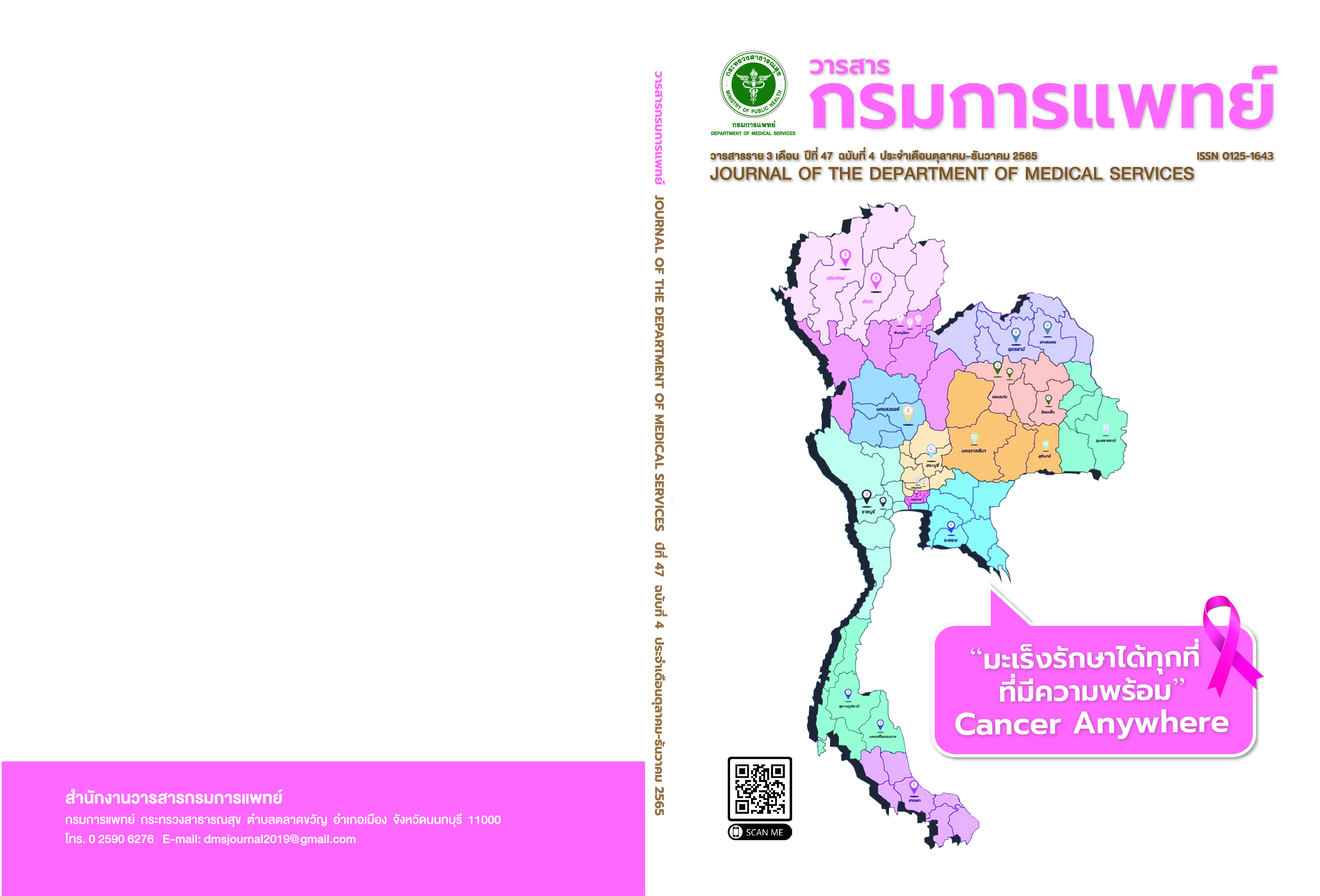สาเหตุและผลลัพธ์ทางคลินิกของภาวะชักต่อเนื่องอ้างอิงตามคำนิยามใหม่
คำสำคัญ:
ชักต่อเนื่อง, ลมชัก, ชักบทคัดย่อ
ภูมิหลัง: ภาวะชักต่อเนื่องเป็นภาวะฉุกเฉินทางระบบประสาทที่สำคัญและพบบ่อยซึ่งเป็นเหตุที่ทำให้ผู้ป่วยทุพพลภาพและเสียชีวิต ในปี ค.ศ. 2015 The International League Against Epilepsy (ILAE) ได้มีการกำหนดนิยามใหม่สำหรับภาวะชักต่อเนื่อง วัตถุประสงค์: การศึกษานี้จึงทำขึ้นเพื่อศึกษาลักษณะอาการชัก สาเหตุ ภาวะแทรกซ้อน รวมทั้งปัจจัยพยากรณ์โรคของภาวะชักต่อเนื่องที่อ้างอิงตามคำนิยามใหม่ วิธีการ: การวิเคราะห์ข้อมูลย้อนกลับจากการรวบรวมเวชระเบียนผู้ป่วยที่ได้รับการวินิจฉัยภาวะชักต่อเนื่องที่เข้ารับการรักษาในโรงพยาบาลวชิรพยาบาล ตั้งแต่ 1 มกราคม 2558-31 มกราคม 2561 จำนวน 150 คน ในช่วงอายุ 18-90 ปี เพื่อหาปัจจัยที่มีความสัมพันธ์ต่อภาวะชักต่อเนื่อง อ้างอิงตามคำนิยามภาวะชักต่อเนื่อง จาก ILAE ปี ค.ศ. 2015 ผล: ผู้ป่วยชักต่อเนื่องจำนวน 150 ราย อายุเฉลี่ย 61.35 (±20.32) ปี พบว่าส่วนมากมีสาเหตุกระตุ้นการเกิดชักอย่างเฉียบพลันถึงร้อยละ 89.9 อัตราการเสียชีวิตพบสูงถึงร้อยละ 48.7 ปัจจัยด้านสาเหตุและลักษณะทางคลินิกที่มีผลต่อผลการรักษาที่ไม่ดี ได้แก่ อายุของผู้ป่วยโดยอายุที่เพิ่มขึ้นทุกๆ 1 ปี จะมีผลต่อการเกิดผลการรักษาที่ไม่ดี 1.03 เท่า (p-value 0.007, 95%CI 1.01-1.05) และผู้ป่วยที่มีภาวะแทรกซ้อนเกิดขึ้นระหว่างนอนโรงพยาบาลพบสูงถึง 16.64 เท่า (p-value < 0.001, 95%CI 4.65-59.63) ส่วนผู้ป่วยที่มีสาเหตุการชักจากระดับยากันชักที่ต่ำกว่ามาตรฐาน มีการพยากรณ์โรคที่ดีกว่าอย่างมีนัยสำคัญทางสถิติ ภาวะแทรกซ้อนที่พบร่วมมากที่สุด ได้แก่ การมีภาวะระบบหายใจล้มเหลวฉับพลัน โรคปอดอักเสบ และการติดเชื้อในกระแสเลือด สรุป: จากการศึกษาภาวะชักต่อเนื่องตามนิยามใหม่ อายุที่เพิ่มขึ้นและการเกิดภาวะแทรกซ้อนระหว่างนอนโรงพยาบาลมีความสัมพันธ์กับผลการรักษาที่ไม่ดี ในขณะที่ผู้ป่วยภาวะชักต่อเนื่องที่มีสาเหตุจากระดับยากันชักต่ำกว่ามาตรฐานจะมีผลการรักษาที่ดีกว่า โดยพบว่าผู้ป่วยส่วนมากจะมีสาเหตุกระตุ้นการเกิดชักอย่างเฉียบพลัน โดยพบสาเหตุเกี่ยวข้องกับภาวะติดเชื้อมากที่สุด
เอกสารอ้างอิง
Leitinger M, Beniczky S, Rohracher A, Gardella E, Kalss G, Qerama E, et al. Salzburg Consensus Criteria for Non-Convulsive Status Epilepticus-approach to clinical application. Epilepsy Behav. 2015;49:158-63.
Lowenstein DH, Bleck T, Macdonald RL. It’s time to revise the definition of status epilepticus. Epilepsia. 1999;40:120–2.
Tiamkao S, Pranbul S, Sawanyawisuth K, Thepsuthammarat K, Integrated Epilepsy Research Group. A national database of incidence and treatment outcomes of status epilepticus in Thailand. Int J neurosci. 2014;6:416-20.
Kalita J, Nair PP, Misra UK. A clinical, radiological and outcome study of status epilepticus from India. J Neurol. 2010;257:224–9.
Amare A, Zenebe G, Hammack J, Davey G. Status epilepticus: clinical presentation, cause, outcome, and predictors of death in 119 Ethiopian patients. Epilepsia. 2008;49:600–7.
Trinka E, Cock H, Hesdorffer D, Rossetti AO, Scheffer IE, Shinnar S, et al. A definition and classification of status epilepticus--Report of the ILAE Task Force on Classification of Status Epilepticus. Epilepsia. 2015;56:1515-23.
Drislane FW. Presentation evaluation and treatment of nonconvulsive status epilepticus. Epilepsy Behav. 2000;1:301–14.
Trinka E, Cock H, Hesdorffer D, Rossetti AO, Schefferm IE, Shinnar S. A definition and classification of status epilepticus – Report of the ILAE Task Force on Classification of Status Epilepticus. Epilepsia. 2015;56:1515-23.
Herman ST, Abend NS, Bleck TP, Chapman KE, Drislane FW, Emerson RG, et al. Consensus statement on continuous EEG in critically ill adults and children, part I: Indications. J Clin Neurophysiol. 2015;32:87-95.
Tiamkao S, Pranbul S, Sawanyawisuth K. Incidences and outcomes of status epilepticus: A 9-year longitudinal national study. Epilepsy Behav. 2015;49:135-7.
Fountain NB. Status epilepticus: risk factors and complications. Epilepsia. 2000;41suppl 2:S23–30.
Lowenstein DH, Alldredge BK. Status epilepticus. N Engl J Med 1998;338:970–6.
Hocker SE, Britton JW, Mandrekar JN, Wijdicks EF, Rabinstein AA. Predictors of outcome in refractory status epilepticus. JAMA Neurol. 2013;70:72-7.
Knake S, Rosenow F, Vescovi M, Oertel WH, Mueller HH, Wirbatz A, et al. Incidence of status epilepticus in adults in Germany: a prospective, population-based study. Epilepsia. 2001;40:759-62.
Leitinger M, Trinka E, Giovannini G, Zimmermann G, Florea C, Rohracher A, et al. Epidemiology of status epilepticus in adults: A population-based study on incidence, causes, and outcomes. Epilepsia. 2019;60:53-62.
Knudsen-Baas KM, Power KN, Engelsen BA, Hegrestad SE. Status epilepticus secondary to glioma. Seizure. 2016;40:76-80.
ดาวน์โหลด
เผยแพร่แล้ว
รูปแบบการอ้างอิง
ฉบับ
ประเภทบทความ
สัญญาอนุญาต
ลิขสิทธิ์ (c) 2022 กรมการแพทย์ กระทรวงสาธารณสุข

อนุญาตภายใต้เงื่อนไข Creative Commons Attribution-NonCommercial-NoDerivatives 4.0 International License.
บทความที่ได้รับการตีพิมพ์เป็นลิขสิทธิ์ของกรมการแพทย์ กระทรวงสาธารณสุข
ข้อความและข้อคิดเห็นต่างๆ เป็นของผู้เขียนบทความ ไม่ใช่ความเห็นของกองบรรณาธิการหรือของวารสารกรมการแพทย์



